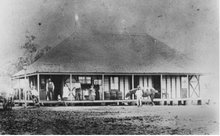My grandfather lived in Sydney all his life. He travelled in the United States and Europe and extensively around eastern Australia but his focus was firmly on home. To him I owe my exposure to the worlds of pottery, fine furniture making, geology, chickens, vegetable and fruit growing, fixing things, hoarding, architecture, history, obscure navigational shortcuts and rural byways and many of the things that I have found most useful in my everyday life. He was curious about the world and to him that meant finding out how things worked – usually by taking them apart and putting them back together. He was a master craftsman who valued and created things that lasted.
I often think of him as I work around the garden. In the middle of Sydney, he raised chickens, zebra finches, budgerigars, apricots, grapes, mulberries, corn, silverbeet, Jerusalem artichokes and many other vegetables. I see birds and interesting plants and want to point them out to him. He never saw our hillside as he died my first year in the United States. I remember watching huge fluffy snowflakes slowly floating outside the windows of a seminar room on the day of his death and visiting his grave in Sydney long after other people had recovered from their grief.
I think of him often – my computer sits on the desk that was made by his father and was in his study as long as I can remember. Some of the plants in my garden come from his. Last time we were in Sydney, my mother gave me a handful of cape gooseberries from her garden whose seed originally came from his. She wanted me to plant them in Marburg. I still haven’t done so, but I found out recently that the cape gooseberry has a long history in this area.
When the settlers started felling trees as required under the terms of their land grants they were left with a tangle of roots, stumps and brush. The easiest way to deal with this was burning. According to Digger Schumann “due to the combined influence of the weather, birds, and the all-seeing eye of God, the first reward that the pioneers received following the hard work of cutting the scrub and the ensuing ‘burn-off’ was a spontaneous crop of cape gooseberries” (pronounced by all as goozbrys). People started saving the seeds in order to plant them whenever they burnt off in order to “give the birds and the Lord just a little help.”
According to Schumann, goozbrys became a vital crop in the Rosewood Scrub because they bridged the gap between clearing the scrub and harvesting major crops. Whole families were involved in picking the crop and getting it ready for the market (which involved removing the papery husk or cape, then packing the fruit in cleaned four gallon kerosene tins and shipping it off to the grower’s agent in Roma Street, Brisbane). The process was so labour intensive that it affected school attendance. He cites the Tallegalla schoolmaster’s concern in 1890 about Mabel Herman who “was absent the whole of previous month picking Cape gooseberries.”
Schumann doesn’t think that it was a major source of income for most families, but that for most, something was better than nothing even with deductions for “freight (iniquitous), commission, (an imposition by bloodsuckers who lived off the backs of hard-working farmers), and last of all, Stamp Duty, (for which all the curses of hell were called to rain down on the Government of the day.)”
As I look at my handful of gooseberry seeds, I smile at Schumann’s accounts and my own memories. My only hesitation is that mention of how the fruit first started growing in the area (birds and the hand of God). Looking for information on the fruit, I read that because of the fruit’s popularity with birds and other wildlife, it can be easily spread and become a problem weed especially in areas of native regeneration. For the moment, the seed will stay out of the ground. But I think the Jaeckels will certainly be making and purveying goozbry pies once they settle into their new life.
Monday, 3 December 2007
Goozbrys and the hand of God
Labels:
everyday life,
farming,
history,
Jaeckels,
plants,
Queensland,
Rosewood Scrub,
Tallegalla
Subscribe to:
Post Comments (Atom)

No comments:
Post a Comment